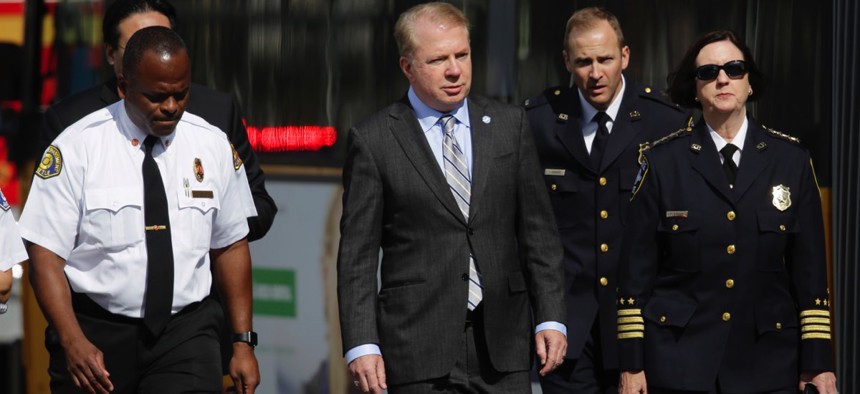Seattle’s Roadmap to 21st Century Community Policing

Seattle Mayor Ed Murray walks with Police Chief Kathleen O'Toole and Fire Chief Harold Scoggins at the scene of a fatal crash involving an amphibious tour vehicle and a charter bus in September. Ted S. Warren / AP Photo
“Mayors must own this,” says the director of the Justice Department’s Community-Oriented Policing Services Office.
WASHINGTON — Ed Murray lacked a public safety background when he became Seattle’s mayor in 2014 and faced a contentious relationship between the police, a court-appointed federal monitor and U.S. Department of Justice.
“We’re still working our way out from under the consent decree,” Murray said Wednesday during the Mayors and Police Chiefs Task Force session of the U.S. Conference of Mayors winter meeting in the nation’s capital.
That consent decree was agreed upon in 2012, following an investigation launched the previous year by the Justice Department into the Seattle Police Department’s history of use of force and biased policing.
Community members and federal authorities needed to re-engage each other—the Justice Department providing technical and financial assistance—to train officers in a “different type of policing,” Murray said.
The biggest challenge for officers is distinguishing a criminal bent on harm from a person undergoing a public health crisis, said Ronald Davis, the Justice Department’s Community-Oriented Policing Services Office director. Identifying a substance abuser or someone suffering from post-traumatic stress or another mental illness can be particularly hard for rookie cops on a late shift, he added—unfair even.
Training is needed to help police assess people in crisis, especially those wielding weapons, and use alternatives to deadly force.
“We talk about de-escalation, but we don’t really get into what it really means,” Davis said. “Mayors must own this.”
For starters, mayors should ensure their city’s police chief has read The President’s Task Force on 21st Century Policing’s recommendations, he said.
Murray said he held Seattle’s police force accountable by completely overhauling the command staff.
Seattle’s current police chief, Kathleen O’Toole, joined Boston’s force in 1979 during the war on crime in Beantown and other major cities, and likened her training to “boot camp.” Back then, cops responded to emergency calls but did no intervention or prevention, she said.
As a result, quality of life went down and the crime rate up—leading police to try community policing in the ’90s. O’Toole blames a shift of focus to counterterrorism efforts following the Sept. 11, 2001, attacks for departments taking their “eye off the ball.”
The consent decree forced Seattle back toward a culture of collaboration and community engagement.
“We have to find the right balance between prevention, intervention and enforcement,” O’Toole said. “And enforcement is a last resort.”
SPD found the funds to hire 20 recruits trained to handle a variety of situations from gang violence to homelessness and extremism to public demonstrations. The revamped strategy also involves rebuilding public trust through greater transparency, posting incident video online within hours rather than attempting to cover up bad press.
Partnerships with mental health professionals and social service providers are essential, and O’Toole attends the same trainings as her officers to evaluate the content.
In the first two months of the new regime, .04 percent of about 6,000 cases resulted in police having to draw their tasers, pepper spray, batons or guns.
Deaths in police custody often involve people in crisis and O’Toole estimates most of Seattle’s officers are interested in reform that prevents unnecessary loss of life.
“Our role as mayors is how do we make policing legitimate over time in the minds of our citizens,” said Antonio Oftelie, Leadership for a Networked World executive director and a Technology and Entrepreneurship Center at Harvard public sector innovation fellow.
Technology like predictive policing and back office transformations help departments shift resources to boster community engagement, he said.
Then there’s the matter of citizen oversight—review boards taking different forms in different cities. Disciplinary action is sometimes killed off by law enforcement agencies, Oftelie said, so boards collaborating with police unions tend to fare better.
While every city will see activists when use of force occurs, transparency diffuses prolonged protesting, Davis said. It’s just one of the reasons SPD’s public satisfaction is on the rise while national numbers deteriorate.
“When I said we we were going to follow the feds, we were going to follow the feds,” Murray said.
Dave Nyczepir is a News Editor at Government Executive’s Route Fifty.
NEXT STORY: 3 Years After Superstorm, the ‘SANDy Act’ Seeks to Apply Lessons Learned






